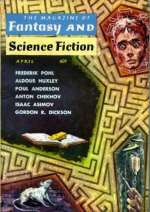|  
 | | | | 

| | “Unto the Fourth Generation”
by Isaac Asimov
First publication: The Magazine of Fantasy and Science Fiction, Apr 1959

During an ordinary day of business, Sam Marten is obsessivly drawn to different men named Levkowich, each with a different spelling.

When I began putting together this Big List in 2005, I started with all the Asimov time travel stories that I could remember. Somehow I forgot about this story which I first read in 1973 in Nightfall and Other Stories. But then, while scouring the 1950s back issues of F&SF for more obscure stories, there it was: Sam Marten’s great, great grandfather brought from his deathbed to meet Sam, and there, also, was a moment of time travel for Sam himself.

Two new sentences were added at the end of the original story for the reprinting in Asimov’s collection, so I thought it would be appropriate to quote those new sentences here: Yet somehow he knew that all would be well with him. Somehow, as never before, he knew. Yet somehow he knew that all would be well with him. Somehow, as never before, he knew. 
| |
| | | | |

 
| |     |